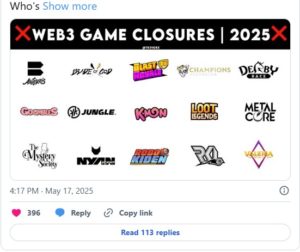Photo by Shutter Speed on Unsplash
If you follow any of the usual [web3] suspects over at their favorite social watering hole, X, you’d think that the periodic cries like “Web3 gaming is dead”, “Web3 gaming is dying”, or my personal favorite, “Web3 gaming is inevitable”, you’d think that there was a concerted effort to will something into existence by mere proclamations (mostly unbridled nonsense). And it’s been a bit of a frenzy of late. I mean, empty bags don’t fill themselves, and down bad tokens are certainly dead — for good, this time.
Joking side, truth is, not a single gamer — not one — gives a crap about any of that noise. But you know who does — besides the blockchains on which said games are deployed? The thousands of speculators, gamblers and otherwise [paid or invested] KOLs (Key Opinion Leaders — yeah, that’s totally a Web3 thing. Nope, I’m not even joking) who seemingly have a vested interest in the financial gains from Web3 gaming.
All said and done, it’s more about the value of vested [gaming] tokens than it is about the merits of the games themselves. Look at this way, if you walk into a casino, you will find dozens of slot machines all themed with various recognizable IP from movies and games all the way down to products you never even heard of. That’s the window dressing — and gambling is the point.
* * *
The focus on financial gain in making and playing Web3 games was doomed from the start. If you follow my writings on LinkedIn, X or even my articles here on Medium, then you already know what I’ve said time and time again. Even MMO games have more gamers focused on their adventures and skirmishes than about how much “money” they can make for their time spent.
Back in Jan 2024, in a lengthy response to the founder of Seedify Fund who wrote a call to action, I closed with this:
“Unless and until Web3 game tech gets relegated to the likes of tech like graphics, networking, audio etc whereby the game comes first in the minds of gamers, every single Web3 game, sooner or later, is going to end up being in a demographic of failed games. Just like trad games. So, it’s less risky to just focus on and market to the Web3 bubble and hope that your game is good enough to survive the exit liquidity churn.”
Later that year, I said this…
It’s been the same discussion since as far back as 2021 when most of us were warning that despite being a blue ocean opportunity for innovation, Web3 gaming was destined to hit a wall because a large swath of them were neither innovative nor fun. They were mostly cash-grab grifts. Greed coupled with the get-rich-quick mentality of crypto in general, fueled by investors throwing money at “devs” who never made a game before, flooded the landscape with tripe and casinos wrapped around games.
Yes — making games is very hard, folks. Some of us have spent decades doing just that.
So as expected, by Summer 2025 when the two to three year games funding runway starting running out, we were already seeing lists of failed Web3 games.
Here’s the thing. While you can find a football field packed on any given Sunday, you’re not likely to find the same number of people in a casino — on any given day. Web3 gaming is very much like that. You have more speculators and gamblers than you do core gamers. And those core gamers are on Steam, Epic Games, consoles, mobile app stores etc. And you’re not bloody well likely to get them to come play your Web3 game. I mean, you made a game with an embedded casino and/or speculatory NFT assets, then cry foul when nobody shows up long enough to fund the cloud costs.
Think about this. If you can make a game — any game — why would you make a Web3 (meaning, one with crypto elements: NFT + token — both of which require a blockchain backend) game instead of just making a game and launching it on any number of games distribution sites? Who is your audience? What is your PMF? What is your ROI flow? All these questions can be found lurking in any number of Web3 pitch decks.
While you’re at it, ponder this. If you can make a game and, for about $100, deploy it to a massive audience of gamers over on Steam, Epic, or mobile, why would you instead opt to make it for the rather small number of Web3 gamers who care more about making money than they do about your game? It’s all about the law of averages. To wit: If a new console hardware comes out, and you happen to be one of the early games on there, you’re likely to make more money than if you came along later on when it’s already flooded with games amid the insurmountable discovery challenges that plague digital stores. Web3 is a whole lot like that; and those who were early, didn’t flood it with good games. Not by a long shot. No, they flooded it with mostly crap games and blatant cash grabs, grifts and everything in between. That’s how the already smaller audience of gamers who would otherwise have liked your Web3 game — regardless of its “crypto” machinations and rep — ended up souring and moving on.
If you’re making a Web3 game, then you’re already facing headwinds, insurmountable odds (If you’re making a game of any kind, you already stand a 90+% chance of failure) against success — and a much, much, smaller audience. And that audience is mostly speculators and gamblers who care more about making money through NFTs and tokens, than they do about the actual game. I mean, did a gambler ever care that the slot machine theme is from their favorite IP? No. They only care about winning, the odds of winning, and the machine’s payout.
So, you go make a casino wrapped in a Web3 “game” because, all said and done, that’s the audience. And it’s a rather small one.
* * *
Through all this “Web3 gaming is dead” noise, you know what I’ve noticed of late? It’s not that a rather shockingly large number of Web3 games are either dead or dying, it’s that all the very same people who were promoting some of these games, P2E (Play To Earn — yeah, that’s another Web3 thing, actually) and all that, are now the same ones changing their collective tunes while suddenly advocating for good Web3 games. Yeah — that after the funding for making Web3 games has already dried up because investors and chains alike are all sitting on dead assets and massive losses. And the end result of that is to pull back on Web3 games funding because — lol — anyone who can afford to make a game, of any kind, is going to deploy it as a Web3 game without financial incentives for doing so. Make it make sense, please.
And there is no easy — nor quick — fix.
I’ve said this since the start, the chains (gaming or none) are the Web3 game publishers now. They have very little choice if they don’t want to be paying costs for a zombie chain with little to no traffic (thus no transactions which generate fees). Unless they all pivot to DeFi (because somehow we need more crypto banks and rails), if they don’t start funding game devs with a decent track record to make games and social apps for their platforms, nothing will change. And with that, what will be left are the catalogs of Web3 games, which, much like slot machines, nobody is playing. And for chains, the law of averages will never work in their favor because for every game that is generating traffic and making some money, there are a hundred others just parked there.
The transient nature of Web3 gaming is much like the transient nature of casino engagements whereby people come and go as their profit and losses flow. When a Web3 “gamer” makes money on one game until he either loses or figures out that the house always wins, he/she is more likely to move on to the next one — especially if it’s new, promoted by KOLs etc. Rinse. Repeat. And that’s why there are more casino games than not; and the chains, investors, KOLs and all involved, have no problem with that because they all know that gamblers and speculators are core audience.
And don’t even get me started on the whole TGE (Token Generation Event — yup, another Web3 thing) thing because that’s a whole article on its own. Let me say this. It doesn’t matter the proclamations or otherwise honest (lol) intentions, the fact is that once the feeding frenzy of a TGE is over and done with and most have claimed, bought — and cashed (much to the detriment of those stuck in the churn) out, the token and whatever casino it is attached to, is as good as dead.
* * *
Trying to make sense of the whole Web3 gaming scene is a non-starter because there is no making sense of it. Sure, any capitalist venture is about making money, but most of those who make games as a hobby, likely already have jobs or other means of supporting themselves. And so, making a casino under the guise of making a game, isn’t all that different from making a standard game that you hope to make money from. Except in Web3, obfuscation is the key — and everyone is in on the [unfunny] joke, while being careful not to say the quiet part out loud.
When you read all the “Web3 gaming is dead” diatribes, the key takeaway shouldn’t be anything like that. Instead, you should be mindful of the fact that Web3 gaming isn’t so special that it somehow defies the well-known odds that 90+% of all games will ultimately fail to yield the expected [financial] results. The only difference is that with a much — much — smaller audience, most of whom are financially vested, Web3 games — regardless of merit — are dead or dying because there aren’t enough saps (erm, gamers) to go around. Either that or the founders (totally reputable game “devs”) already cashed out and moved on to the next thing. And in the case of the latter, only in Web3 can a game not just fail and shut down without the masses calling it a rug (yeah, that’s Web3 wording for cashed out) while pointing the finger at the very same people they gave money to. You’re literally not supposed to fail. That despite the fact that games fail (some don’t even get released) — all the time.
* * *
I have to close this by saying that there are seemingly no lessons to be learned from the on-going, slow roll, demise of Web3 gaming. It’s nothing new — and we’ve been here before. I mean, I know all too well the toll that just making a Web3 anything can take — even for experienced (remember Shrapnel?) game devs. As someone who has been doing this for a minute, my only advice remains the same. Just make a good game that some people will play, regardless of the Web3 machinations. If you make a good game, even if you don’t win over everybody — and God knows you’re not bloody well likely to, anyway — you can still build an audience that’s likely to stick around. But screw those “gamers”, and you’re done; because in this current [gaming] arena, there are no second chances.
Go make your Web3 casino game, champ. Godspeed!
ps. My recent [lengthy] exchanges (1, 2) on X, inspired me to write this article to add to my body of work that are the on-going Web3 shenanigans.


